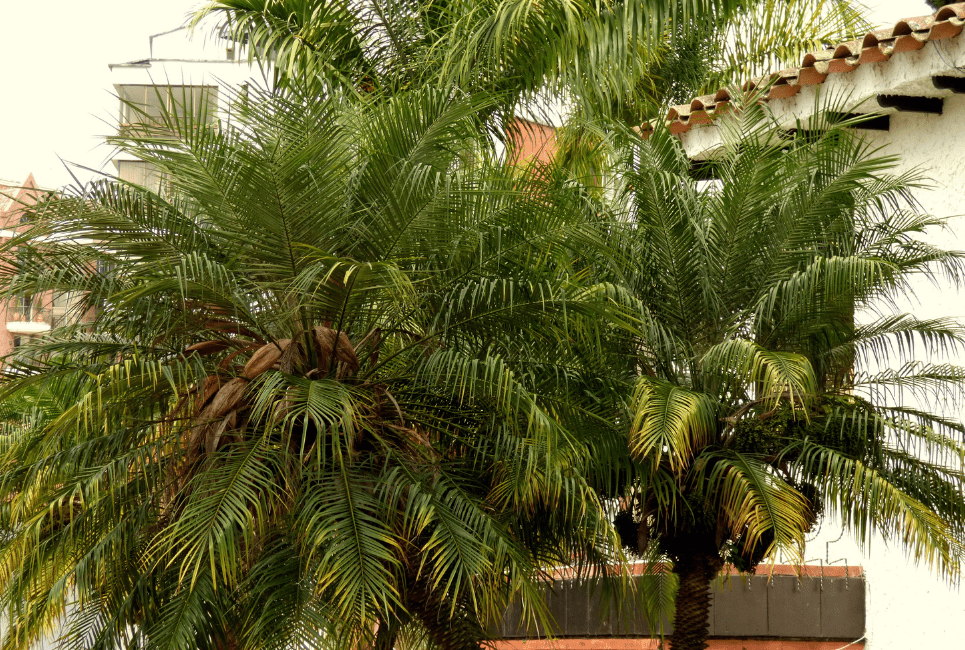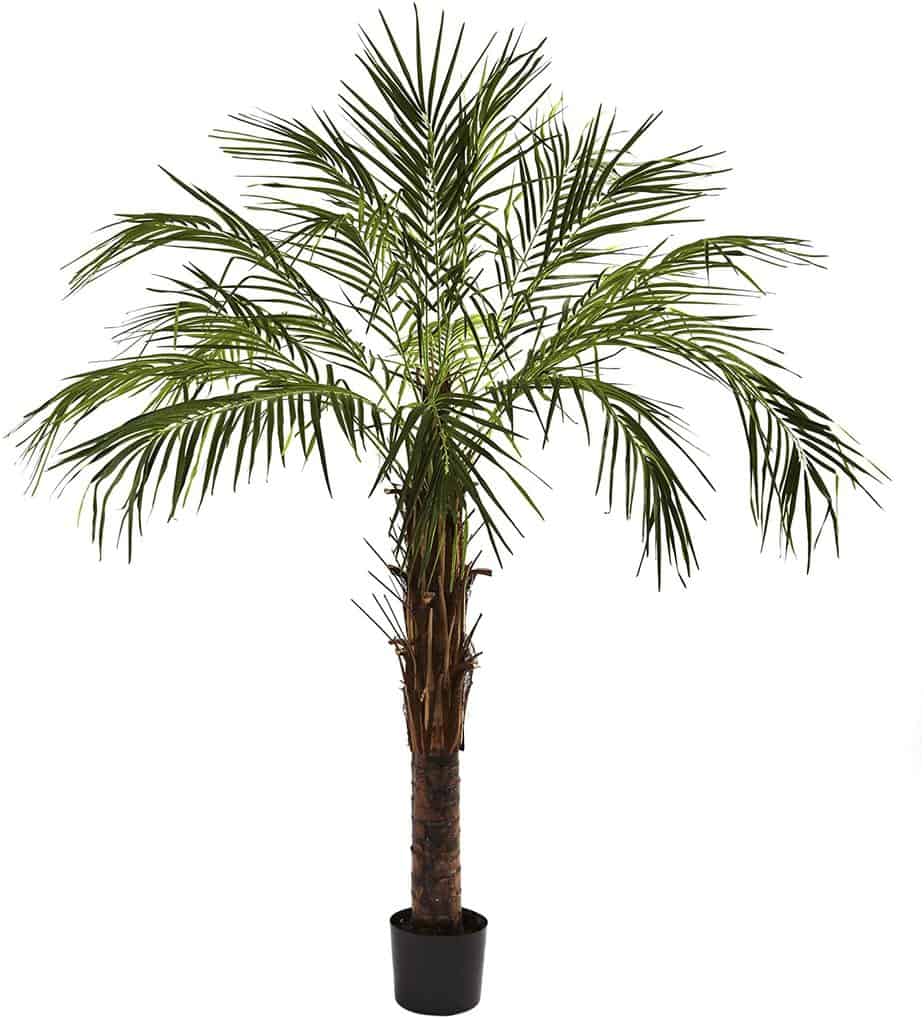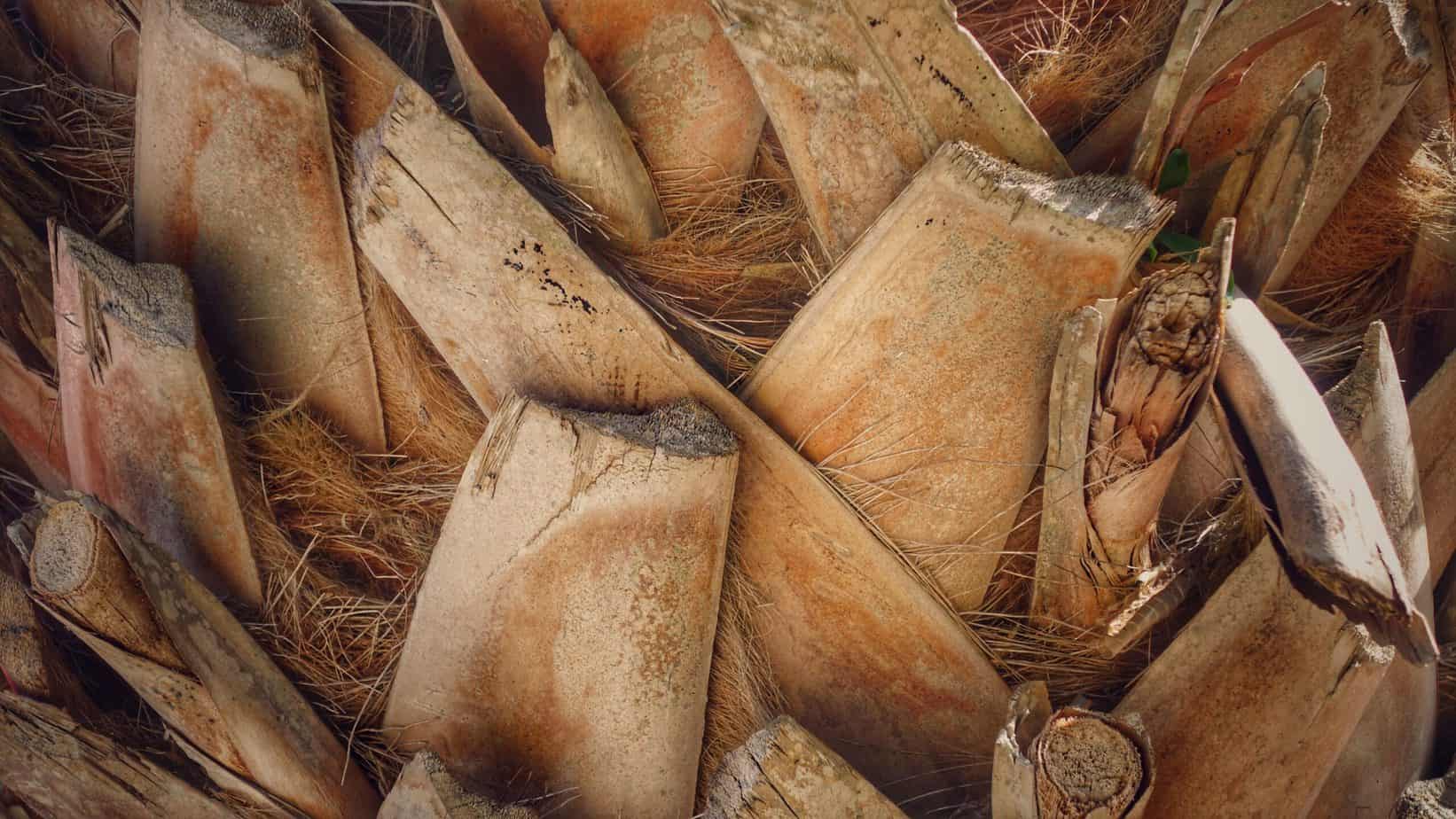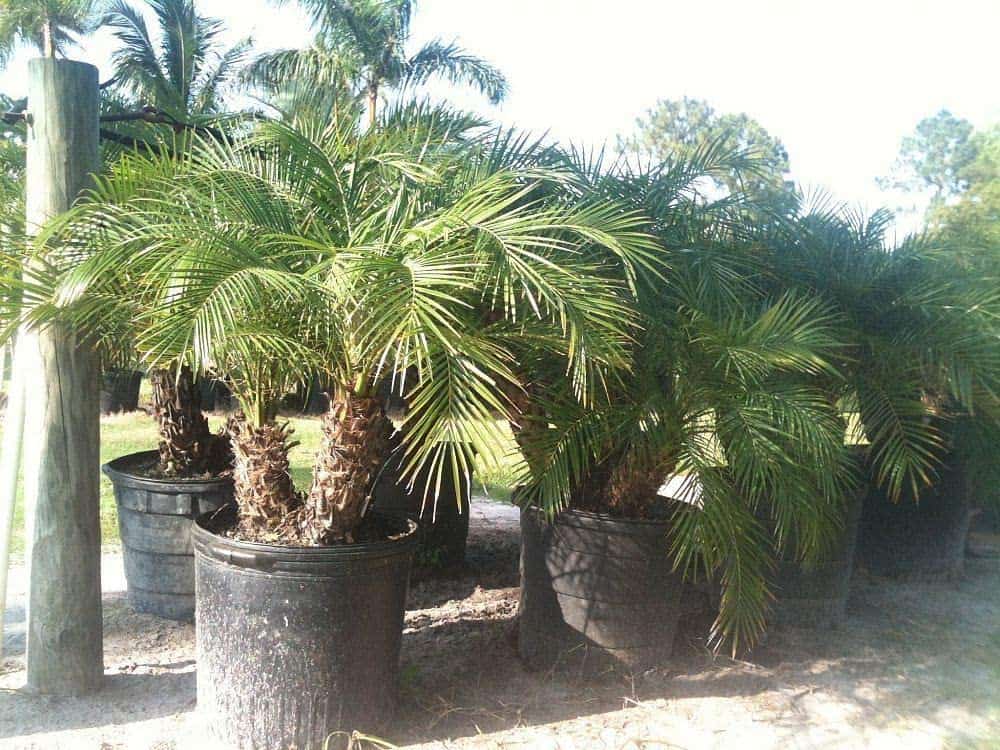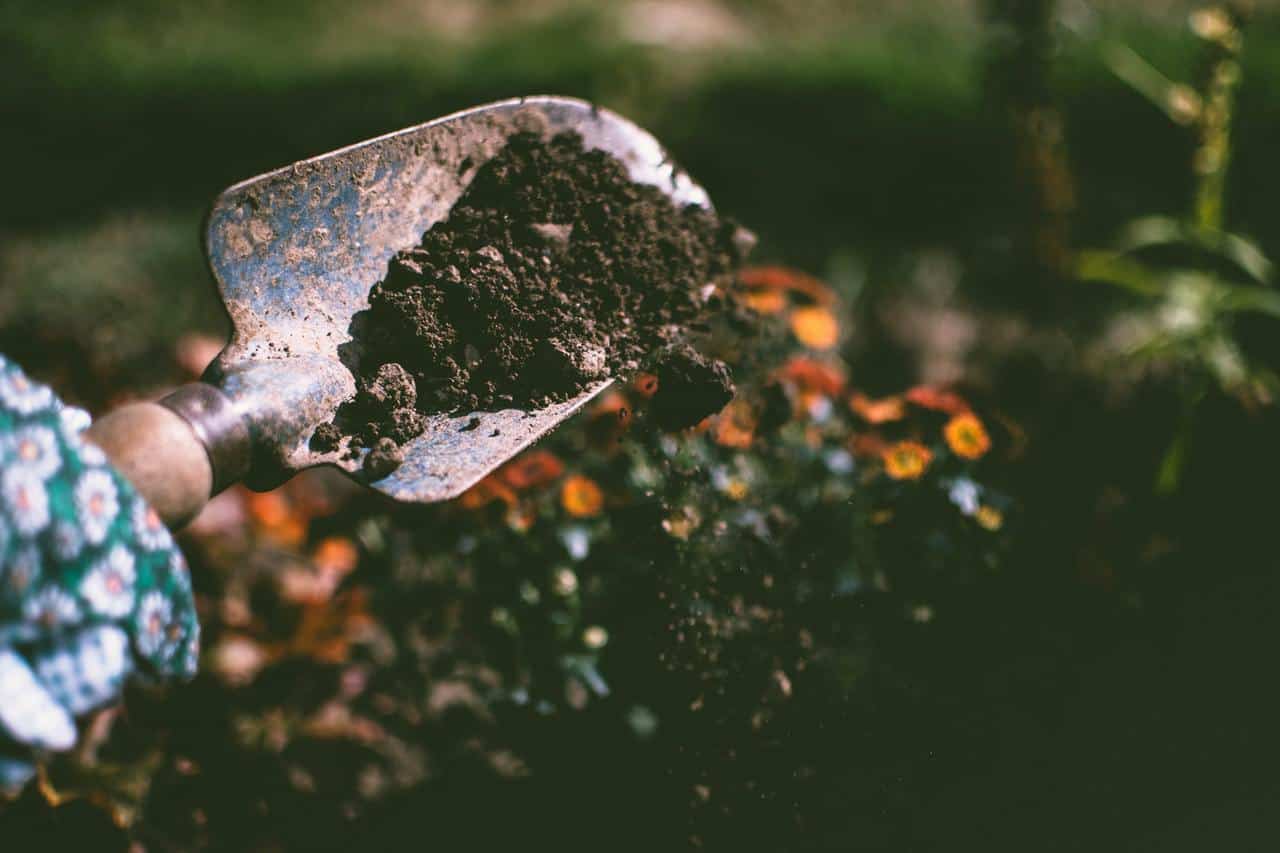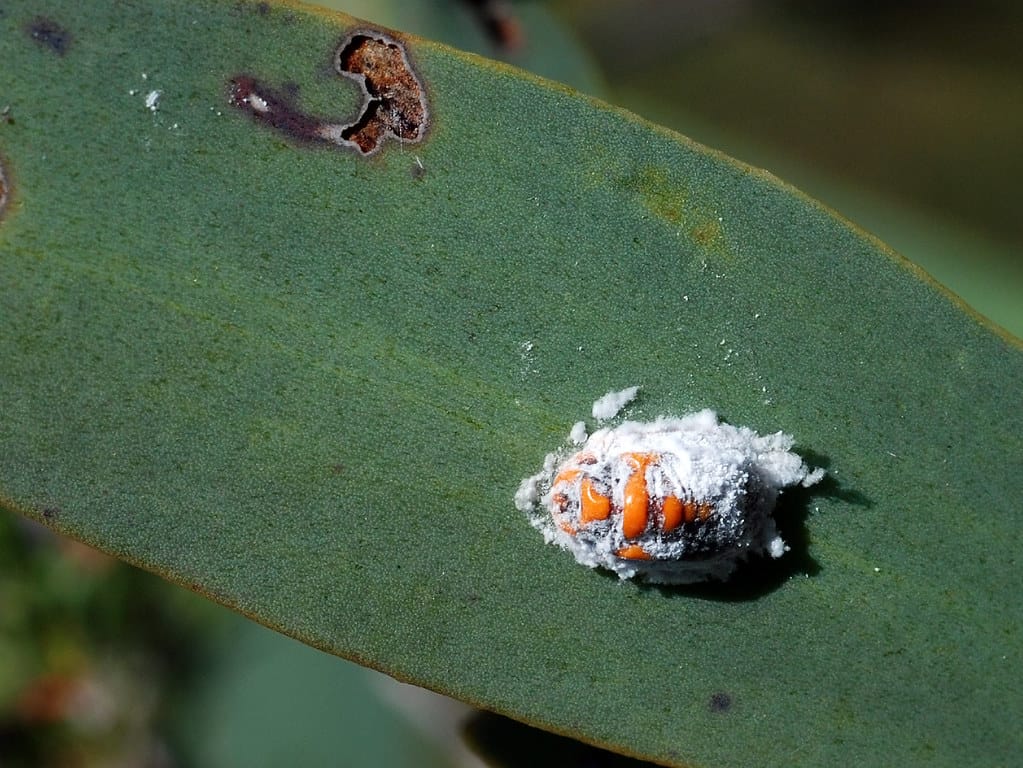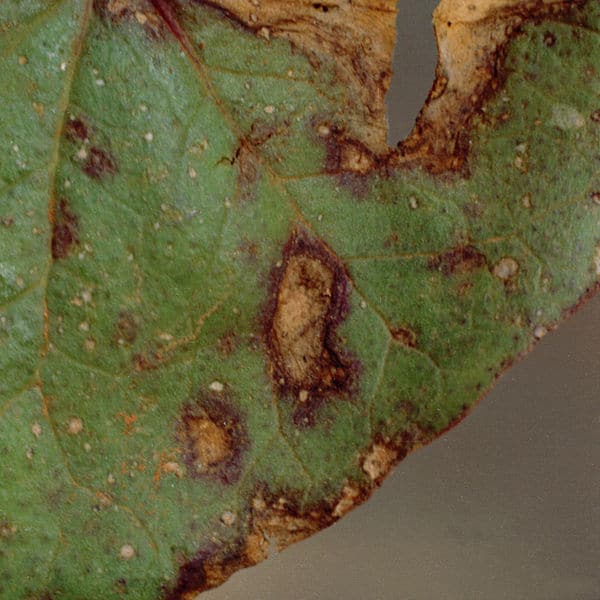- Boxwood Tree Guide: What You Need to Know about Boxwood Shrubs - April 10, 2022
- Hornbeam Tree: All You Need to Know - April 8, 2022
- European Fan Palm: All You Need to Know - March 30, 2022
The Robellini palm, aka dwarf date palm, pygmy date palm, miniature date palm, or Phoenix roebelenii in scientific terms, is a dwarf type of palm tree that reaches the height of just 6 to 12 feet when mature. However, despite its diminutive stature, it’ll have a span of around 10 feet across and a thick crown of attractive 3-foot palm leaves.
The crown usually hides small bunches of flowers, which develop into small dates that are black at first before turning a deep red. The Robellini palm is especially productive when planted in small clusters, or will do just fine in a container. The palm will only grow in humid, warm environments and can’t withstand frost.
Our Bottom Line Upfront
Robellini palm, aka pygmy date palm, or dwarf palm, is a miniature palm tree for tropical and subtropical environments but is compact enough to be grown in a container and kept indoors during winter in colder environments.
The Robellini palm is a typical “dooryard” palm, acting as a centerpiece item next to or in front of the front door. It’s used that way when planted in a pot or the ground.
What’s the Robellini Palm?
The Robellini palm is a miniature palm tree that originates in Africa and Asia. It naturally grows in humid, warm climates and usually grows under the wing of big trees in tropical rainforests.
Many people keep Robellini palms as indoor plants thanks to their beautiful appearance and natural ability to purify indoor air in homes and offices. The palms also complement homes with pets because they’re known to be harmless to people, dogs, and cats.
Fruit and Flowers

Although the Robellini palm is a close relative of the bigger edible date palm, it’s not primarily cultivated for its fruit—the fruit’s more like a hole surrounded by a slim edible skin, as opposed to something that could be relished.
Robellini palms are slow-growing, so it can take 5 to 7 years after planting for the trees to flower and produce fruit. Seeds also take quite a while to germinate, usually requiring 3 to 6 months. The Robellini palm’s flowers are long bunches of cream-hued blooms that come out of the middle of the canopy every spring, followed by red fruits that darken as they ripen during the summer.
Fronds
The 6 to 8-foot canopy consists of long, downy fronds made up of many narrow leaflets that make the palm look soft overall. Having said that, the leaflets have sharp spines at the tip, but the palms don’t have the stout appearance of palms with stiff fronds.
Trunk
The Robellini palm naturally has one trunk only, though it’s usually planted in tight clusters which create the appearance of a palm with many trunks as it grows, often resulting in attractive curved trunks.
How to Propagate Robellini Palms
It’s easy to propagate the Robellini palm if the mature plant is producing offshoots or suckers. Keep the suckers separate from the bottom of the mature plant, making sure to keep all the roots intact.
Plant the new Robellini palm in a small container with wet but well-drained soil and keep it in an area that gets bright but indirect sunshine. After two months, you can move the new palm plant to a place that gets brighter sunlight.
Uses of the Robellini Palm
In semi-tropical and tropical environments, the Robellini palm can be planted outside in small clusters all year round.
Robellini palms are the favorite landscape plants all over the country, but they shouldn’t be grown at the seaside since they can’t withstand salty conditions. In areas with cooler climates, the Robellini palm is an amazing large indoor houseplant.
Robellini palms are perfect additions to entryways, decks, pool landscaping, as well as office, commercial, and home settings.
How to Grow Robellini Palms
The Robellini palm is native to Southeast Asia, so it flourishes in USDA hardiness zones 9 to 11, which have conditions similar to those in Southeast Asia.
In USDA hardiness zones 9 to 11, temperatures don’t regularly drop under -1°C (30°F), but the palm is known to grow in USDA hardiness zone 9b (-6°C to -1°C or 20°F to 30°F) without significant cold protection. Having said that, the Robellini palms can grow well in a container on a patio or deck during the summer but will need winter protection indoors before the first frost.
Robellini palms do well along riverbanks with partial shade to full sunlight exposure, so they require rich organic soil and heavy irrigation to thrive.
Can Robellini Palms Be Grown in Containers?
Robellini palms are perfect plants to grow in a container thanks to their relatively small size. The palms usually thrive when they’re slightly root-bound, making containers an ideal place to plant them. The secret to successfully growing Robellini palms in a pot is to ensure you regularly fertilize the plant since the soil may not provide the necessary nutrients and not overwater it.
How to Take Care of the Robellini Palm
This miniature palm tree requires certain conditions to flourish both outdoors and indoors. In general, Robellini palm trees require warm, wet conditions, consistent sunlight, and regular watering. The palm is dioecious, which means individuals are female or male—dioecious plants have either female or male flowers, not both.
There must be at least one male Robellini palm growing in or near your garden for the female Robellini palms to be pollinated and bear fruit. Healthy palms will produce little creamy white flowers during the spring, which eventually will develop into tiny reddish-purple dates when they’re ripe. These dates carry the seeds of Robellini palms.
Soil Requirements
Robellini palms thrive in moist, but well-drained soils. In other words, the soil needs to have adequate levels of organic matter to help retain moisture, in addition to lots of inorganic matter (like perlite) to help with drainage.
Do not use soil that’s either extremely alkaline or extremely acidic. Robellini palms need soil that’s slightly alkaline to acidic. You can use a pH meter to measure the pH level of the soil. If the soil’s pH level is too low or too high, treat the soil with sulfate or lime to fix the pH.
Water Requirements
While the Robellini palm can withstand brief spells of drought, this tree should be regularly watered so the soil doesn’t completely dry out. Water deeply when the soil has somewhat dried.
Newly-planted Robellini palm trees should be watered every day for the first 14 days to help their root systems get established, after which you can reduce the watering to twice or thrice per week, based on temperatures. Generally speaking, the perfect time to irrigate Robellini palms is early in the evening or morning, and you shouldn’t water them in the hottest time of the day.
Light Requirements
The quantity of light required by the Robellini palm depends on whether it’s being grown outdoors or indoors.
- Robellini palms planted indoors, require at least 6 hours of direct sunshine every day.
- When it comes to Robellini palms planted outdoors, the right amount of light will depend on your geographic location. For instance, in climates with intense ultraviolet rays and extreme heat, Robellini palms will benefit from being shielded from the hot sun. In milder climates, the palms should be grown in an area that gets the full sun, not less than 6 hours of direct sunlight every day.
Temperature and Humidity Requirements
Like most palm tree species, Robellini palms require warm, wet conditions. This dwarf palm survives in USDA hardiness zones 9-11 and isn’t frost-resistant.
If your area experiences severely cold winters, be sure to plant your dwarf palm in a pot so you can move it indoors during winter. If you want to grow your miniature palm indoors, make sure it stays away from air conditioners or drafty vents.
Applying Fertilizer
The Robellini palm will benefit from fertilization regularly. Mature palms should be fertilized thrice every year with a well-balanced fertilizer created for palms. Seedlings and younger palms need to be fertilized once every month to enhance healthy growth.
Pruning the Robellini Palm
Occasional pruning is beneficial for the Robellini palm. However, it’s vital to do the pruning correctly to not compromise the plant’s health. As such, it’s best to call in a landscaper whose specialty is pruning palm trees to have your palm professionally pruned.
The 1.8m (6-foot) long fronds of Robellini palms may need reining in on occasion. Pruning the Robellini palm isn’t a daunting prospect and only requires intermittent removal of diseased or aged foliage. Other ways to maintain the Robellini palm include cleaning up spent leaves or removing offshoots since this palm tree is propagated through seed dispersal.
Protecting the Robellini Palm
To protect Robellini palms from damage caused by cold weather, be sure to take several steps to maintain their health once the weather becomes unfriendly.
Firstly, you can apply a spray-on product to protect the palms from frost. Secondly, it’s also best to water deeply before a frost. In addition, applying a thick mulch layer around the bottom of the palms will help prevent frost damage, too.
When temperatures rise too high, Robellini palms will withstand the temperature for some time, but you should make sure to keep the soil well-watered. It’s best to use shade cloth or any other method to prevent too much heat from burning or curling up the leaves of your palms.
Robellini Palm Pests and Diseases
Not many kinds of pests and diseases afflict Robellini palms. Understanding what made your miniature palm turn yellow or why it’s growing slowly will help you identify some common pests and diseases.
Insect Infestations
In general, palm trees are resistant to many common insects that attack other decorative plants. Scale is one common insect that damages Robellini palm trees. This small, largely immobile insect attaches to the palm’s fronds. Only female and young scale insects feed on Robellini palms, but they may cause the whole plant to die out if not dealt with.
Treating scale is ideally done with an FDA-approved insecticide specifically made to eliminate scale insects on palm leaves. Make sure to treat your Robellini palm during its least active growing period, ensuring that the fronds are fully sprayed from top to bottom.
The trunk and bud must also be thoroughly sprayed with insecticide to get rid of male adult scale insects. While the young and female scale insects are largely immobile, adult males don’t feed on Robellini palms.
Other less common insect pests include mealybugs, weevils, and caterpillars. These insects are easy to control with pesticides. Remember that the young Robellini palm leaves are usually covered in whitish, thin fuzz, often confused with insect infestation.
Fungal Infections
Fungal infections are one of the most common diseases that affect Robellini palms. The palm is likely to suffer bud rot, a type of fungus that affects newly-developing leaves and may spread to the roots and trunk.
Bud rot can make Robellini palms turn yellow and may cause the plants to cease growing. The infection typically results from overwatering, especially when water collects on the trunk and crown. Fungal growth most commonly occurs in hot, humid settings.
Overwatering and bad drainage may also result in a fungal disease in the roots known as root rot. This type of fungus destroys the roots, stopping the dwarf palm from receiving the nutrients it requires for proper growth and health.
To prevent root rot, make sure to not overwater your Robellini palms and ensure they have excellent drainage.
Leaf Spot Fungus
Leaf spot fungus attacks the fronds or leaves of Robellini palm plants. The disease resembles tiny abscesses on the palm’s fronds and can make the plant turn yellow.
Leaf spot fungus has a whole host of causes, and the simplest way to treat it is to use over-the-counter antifungal remedies. If it’s not treated, the disease will infect the whole palm tree, ultimately destroying it.
Pestalotiopsis Fungus
In the early stages of pestalotiopsis fungus, it resembles leaf spot fungus. Spots initially appear on the fronds that can look yellow, black, or brown. As the infection spreads, these spots will expand and often acquire a black ring. If it’s not treated, pestalotiopsis fungus will spread to the bud, making it rot and hindering the palm’s growth rate. Pruning the infected leaves carefully and using an antifungal product can halt the spread of this fungal infection.
FAQs
Answer: A Robellini palm tree typically grows to 6 to 12 feet.
Answer: Here’s how to care for Robellini palms:
• Check the soil moisture of your Robellini palm and ensure it is sufficient. The soil should be wet but not soggy.
• Water the Robellini palm once the soil gets slightly dry. Don’t let the palm stay in severe drought conditions.
• Make sure the palm’s soil is well-drained.
• Check the pH level of the soil and fix it with sulfate and or lime if the pH level is very high or low.
• Check the Robellini palm’s leaves for any damage due to nutrient deficiencies like yellowing leaves or chlorosis.
• Apply well-balanced fertilizer to your Robellini palm. Magnesium and potassium are specific nutrients whose deficiency causes leaf dieback. Apply fertilizer three times a year. Younger palms, like seedlings, should be fertilized once a month.
Answer: Yes, you can trim a Robellini palm tree. Outdoors or indoors, Robellini palms create a bold, tropical atmosphere. The palms require minimal pruning, except to get rid of diseased, damaged, or dead fronds, or to trim their long, dangerous thorns.
Answer: Robellini palms grow slowly and will usually take 5-7 years to mature. Seeds also take quite a long to germinate, usually requiring 3-6 months.
Answer: Robellini palms can grow well in USDA hardiness zones 9 to 11. People living in cooler areas should grow this plant in containers to protect them during winter. Palms get damaged by cold when temperatures dip under 30°F.
The Bottom Line on the Robellini Palm
The Robellini palm is an excellent landscaping tree with a slow growth rate and doesn’t grow so tall (6 to 12 feet). It thrives in hot, wet climates as long as insect infestations and fungal infections are kept at bay. The Robellini palm flourishes in containers and is a lovely low-maintenance indoor plant that rarely grows taller than 5 feet. When ripe, the red seed pods of the Robellini palm are edible.
Growing stunning Robellini palms isn’t as hard as you might imagine. Robellini palms are amazing plants that can help you create a tropical atmosphere in your landscape. The palms thrive in clusters as well as look amazing when planted near larger palm tree species to add some definition and color.
Make sure to apply a balanced fertilizer to your Robellini palms. For established palms, apply fertilizer three times a year. And younger Robellini palms, like seedlings, require fertilization once every month.

